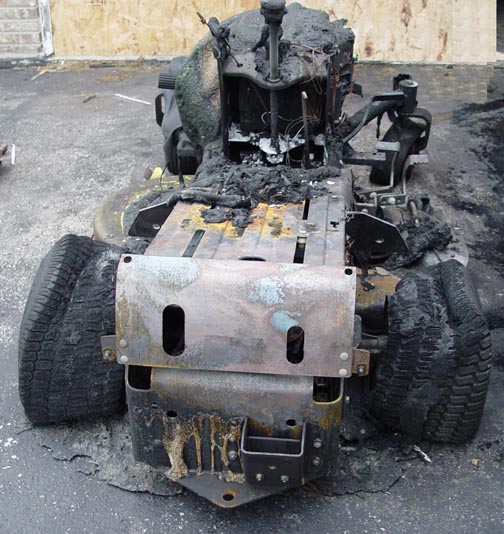
Figure 1
Worm gear hose clamps can be the root cause of fuel or volatile fluid leakage in vehicles. Figure 2 shows a typical worm gear style hose clamp where the screw is tightened to provide clamping force to the hose. The middle hose in the photo depicts the proper application of the hose clamp to the hose with appropriate tightening torque. If the clamp is over tightened or over torqued, the condition to the far right in the photo is shown with severe deformation occurring to the hose. Excessive tightening can lead to the extrusion of rubber through the worn gear slots as shown in Figure 3, which can damage the hose and cause a fuel leak.

Figure 2

Figure 3
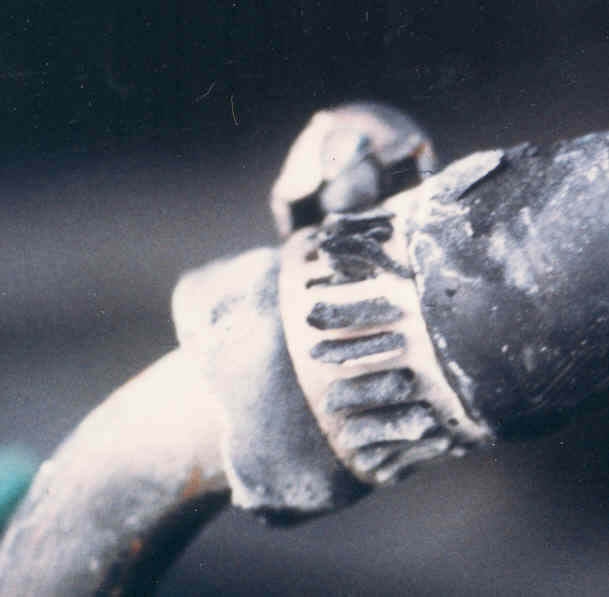
Figure 4
Figure 4 is a view of a hose and clamp which were a source of fuel leakage that caused a fire loss, totaling the vehicle. The extruded rubber through the over tightened hose clamp is quite evident. The hose fitting leaked profusely when tested. The fire was extinguished early, leaving the offending hose clamp, which was installed by the insured, intact. According to the insured, he noticed the leak and merely tightened the clamp to stop the leak, which worked for a short period of time before the hose failed.
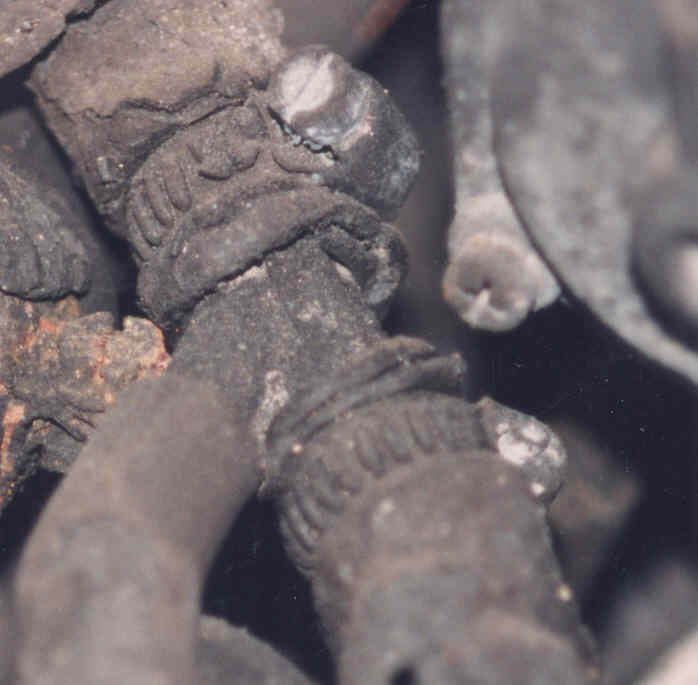
Figure 5
Figures 5 and 6 show views of over tightened hose clamps that caused fires in other vehicles. A long “tail” of worm gear slots is another indicator that the clamp was most likely over tightened.
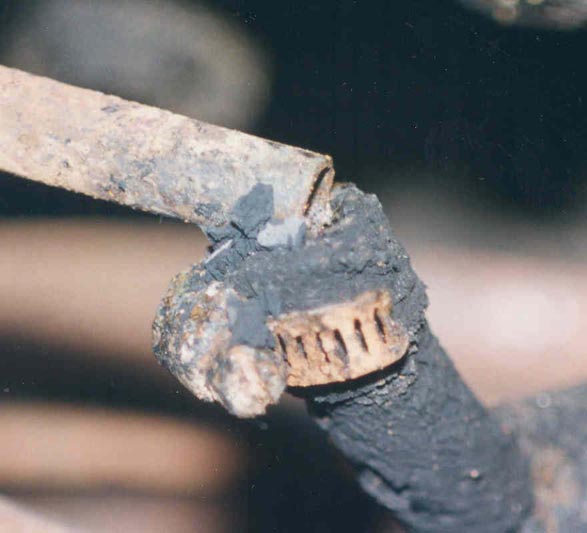
Figure 6
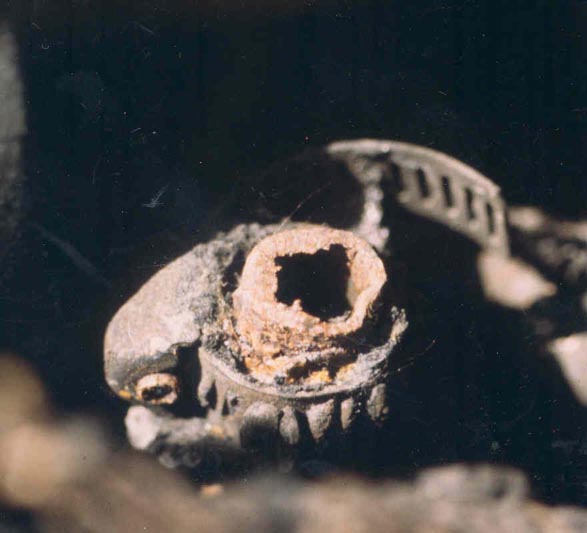
Figure 7
In Figure 7, a repair shop damaged a fuel tube and repaired it by merely sawing it off, replacing it with a rubber hose and worm gear hose clamps. The sharp edges of the fuel tube, plus over tightening of the hose clamp caused fuel leakage, a fire and total loss of the vehicle. Notice the excessively long slotted “tail” in Figure 7 attesting to over tightening as a factor in the loss.

Figure 8
Although worm gear hose clamps are used occasionally by vehicle manufacturers, the nut and bolt design shown in Figure 8 is quite common. The nut and bolt clamp cannot be over tightened as it has a limited range of travel. The problem with the worm gear design is that it can be over tightened by the untrained, which is a misuse of the product. Worm gear hose clamps require specific ranges of tightening torque and should not be tightened above the range limit. When analyzing a fire loss where a fuel leak is suspected, the existence of over tightened worm gear hose clamps may be the cause and also may not be original equipment.
BACK TO C. ROBERTS CONSULTING ENGINEERS HOME PAGE,
WWW.CROBERTS.COM

Figure 2

Figure 3

Figure 4
Figure 4 is a view of a hose and clamp which were a source of fuel leakage that caused a fire loss, totaling the vehicle. The extruded rubber through the over tightened hose clamp is quite evident. The hose fitting leaked profusely when tested. The fire was extinguished early, leaving the offending hose clamp, which was installed by the insured, intact. According to the insured, he noticed the leak and merely tightened the clamp to stop the leak, which worked for a short period of time before the hose failed.

Figure 5
Figures 5 and 6 show views of over tightened hose clamps that caused fires in other vehicles. A long “tail” of worm gear slots is another indicator that the clamp was most likely over tightened.

Figure 6

Figure 7
In Figure 7, a repair shop damaged a fuel tube and repaired it by merely sawing it off, replacing it with a rubber hose and worm gear hose clamps. The sharp edges of the fuel tube, plus over tightening of the hose clamp caused fuel leakage, a fire and total loss of the vehicle. Notice the excessively long slotted “tail” in Figure 7 attesting to over tightening as a factor in the loss.

Figure 8
Although worm gear hose clamps are used occasionally by vehicle manufacturers, the nut and bolt design shown in Figure 8 is quite common. The nut and bolt clamp cannot be over tightened as it has a limited range of travel. The problem with the worm gear design is that it can be over tightened by the untrained, which is a misuse of the product. Worm gear hose clamps require specific ranges of tightening torque and should not be tightened above the range limit. When analyzing a fire loss where a fuel leak is suspected, the existence of over tightened worm gear hose clamps may be the cause and also may not be original equipment.
BACK TO C. ROBERTS CONSULTING ENGINEERS HOME PAGE,
WWW.CROBERTS.COM

Figure 4

Figure 5
Figures 5 and 6 show views of over tightened hose clamps that caused fires in other vehicles. A long “tail” of worm gear slots is another indicator that the clamp was most likely over tightened.

Figure 6

Figure 7
In Figure 7, a repair shop damaged a fuel tube and repaired it by merely sawing it off, replacing it with a rubber hose and worm gear hose clamps. The sharp edges of the fuel tube, plus over tightening of the hose clamp caused fuel leakage, a fire and total loss of the vehicle. Notice the excessively long slotted “tail” in Figure 7 attesting to over tightening as a factor in the loss.

Figure 8
Although worm gear hose clamps are used occasionally by vehicle manufacturers, the nut and bolt design shown in Figure 8 is quite common. The nut and bolt clamp cannot be over tightened as it has a limited range of travel. The problem with the worm gear design is that it can be over tightened by the untrained, which is a misuse of the product. Worm gear hose clamps require specific ranges of tightening torque and should not be tightened above the range limit. When analyzing a fire loss where a fuel leak is suspected, the existence of over tightened worm gear hose clamps may be the cause and also may not be original equipment.
BACK TO C. ROBERTS CONSULTING ENGINEERS HOME PAGE,
WWW.CROBERTS.COM

Figure 6

Figure 7
In Figure 7, a repair shop damaged a fuel tube and repaired it by merely sawing it off, replacing it with a rubber hose and worm gear hose clamps. The sharp edges of the fuel tube, plus over tightening of the hose clamp caused fuel leakage, a fire and total loss of the vehicle. Notice the excessively long slotted “tail” in Figure 7 attesting to over tightening as a factor in the loss.

Figure 8
Although worm gear hose clamps are used occasionally by vehicle manufacturers, the nut and bolt design shown in Figure 8 is quite common. The nut and bolt clamp cannot be over tightened as it has a limited range of travel. The problem with the worm gear design is that it can be over tightened by the untrained, which is a misuse of the product. Worm gear hose clamps require specific ranges of tightening torque and should not be tightened above the range limit. When analyzing a fire loss where a fuel leak is suspected, the existence of over tightened worm gear hose clamps may be the cause and also may not be original equipment.
BACK TO C. ROBERTS CONSULTING ENGINEERS HOME PAGE,
WWW.CROBERTS.COM

Figure 8
BACK TO C. ROBERTS CONSULTING ENGINEERS HOME PAGE,
WWW.CROBERTS.COM
WWW.CROBERTS.COM